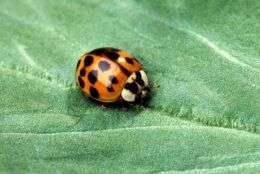Ladybugs may be cute, but watch out when they get near wine

Ladybugs may look pretty but they also have a dark side. In some places, the polka-dotted insects have become a nuisance by invading homes and crops, including some vineyards. To make matters worse, the bugs produce a foul-smelling liquid that, besides irritating homeowners, can be inadvertently processed along with grapes and taint the aroma and flavor of wine.
Now, chemists at Iowa State University in Ames, Iowa, say they have identified several compounds that are responsible for the ladybug’s noxious odor, a finding that could lead to new strategies to detect and eliminate the offensive compounds. Their study, which could lead to better tasting wine, was presented today at the 233rd national meeting of the American Chemical Society.
A growing number of winemakers say that their wines have an abnormal aroma and flavor, known as ‘ladybug taint,’ that resembles the bug’s characteristic odor. Winemakers report that there are more ladybugs in vineyards and on the grapes during harvest. Experts believe that the bugs accidentally become mixed into the juice during processing and fermentation, resulting in inferior wine.
Led by Jacek Koziel, Ph.D., an agricultural engineer at the university, the Iowa researchers used a highly-sensitive multidimensional gas chromatograph and a panel of human ‘sniffers’ to characterize and identify the odors emitted by a group of live ladybugs — as many as 300 in all. All of the ladybugs were a single species of multicolored Asian ladybird beetle (Harmonia axyridis).
After sealing the bugs in test tubes in batches of five each, the odors they emitted were carefully analyzed by the researchers who detected 28 different odors. Of these, Koziel and his associates identified four chemicals that were most responsible for the characteristic ladybug odor.
All of the chemicals belong to a class of compounds called methoxypyrazines, which are potent odor-producing compounds also found in other animals and plants. The compounds are not considered harmful to humans. However, according to Koziel, “even tiny amounts can be detected by the human nose.” Ladybugs are loaded with these foul-smelling compounds, he adds.
Used primarily as a defense mechanism to deter predators when the bugs are threatened or attacked, methoxypyrazines are said to resemble the odor of green bell peppers or roasted peanuts.
Because of the potency of the compounds, even a slight amount can potentially affect a wine’s character, Koziel says. Although he and his associates did not conduct any actual wine studies, recent studies by others have shown that an increase in ladybug toxins can significantly decrease the natural fruit and floral intensities in wine.
While similar compounds have been detected by others in ladybugs, he says that his group has identified and characterized a higher number of the chemicals than others, including a new one, called DMMP (2,5-dimethyl-3-methoxypyrazine), that has not previously been reported in ladybugs.
Ladybugs, also known as ladybirds or lady beetles, generally are considered beneficial insects. Most notably, ladybugs are a significant source of biological control for aphids, tiny plant-sucking insects that damage several major crops. One such aphid pest is the soybean aphid, an invasive species that has recently spread across the Midwestern areas of the United States.
“With this new prey, the abundance of one species of lady beetle, Harmonia axyridis or the multicolored Asian ladybird beetle, has also increased,” says study co-author Matt O’Neal, Ph.D., an entomologist at the university. Now, these beneficial insects are becoming a pest themselves by invading homes, crops and vineyards, he says. “They are basically a good bug gone bad.”
Source: American Chemical Society















